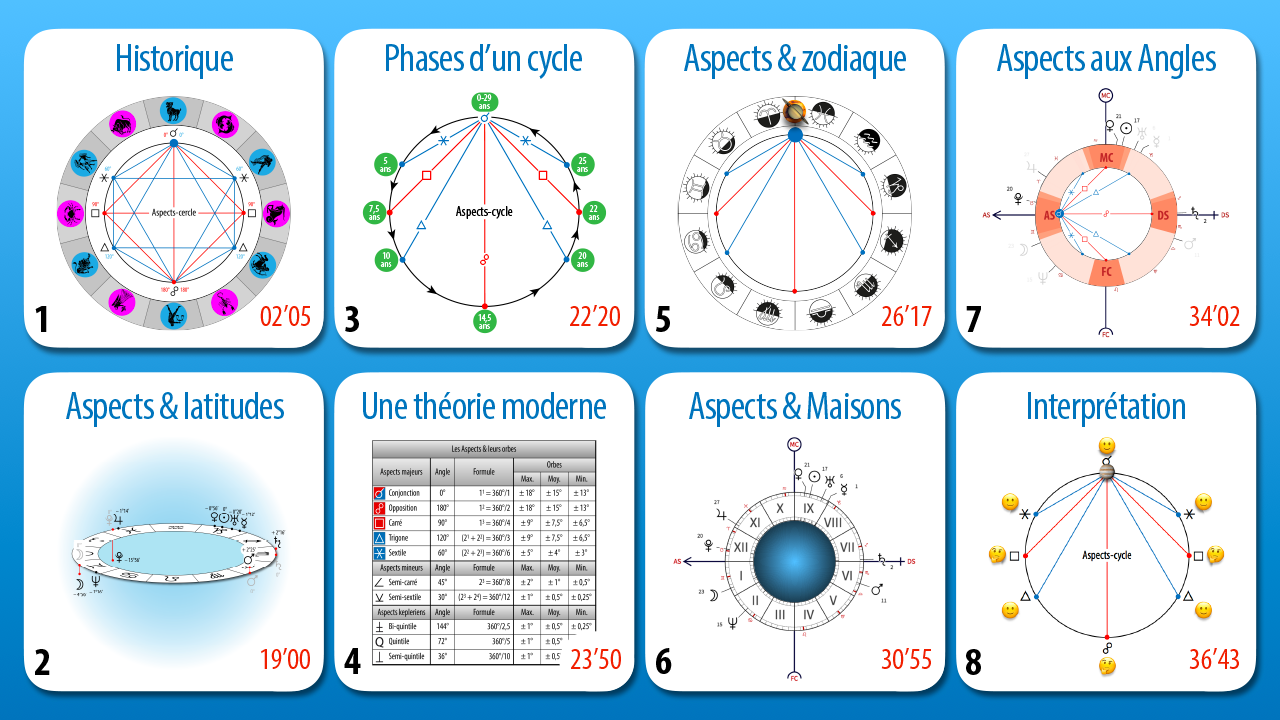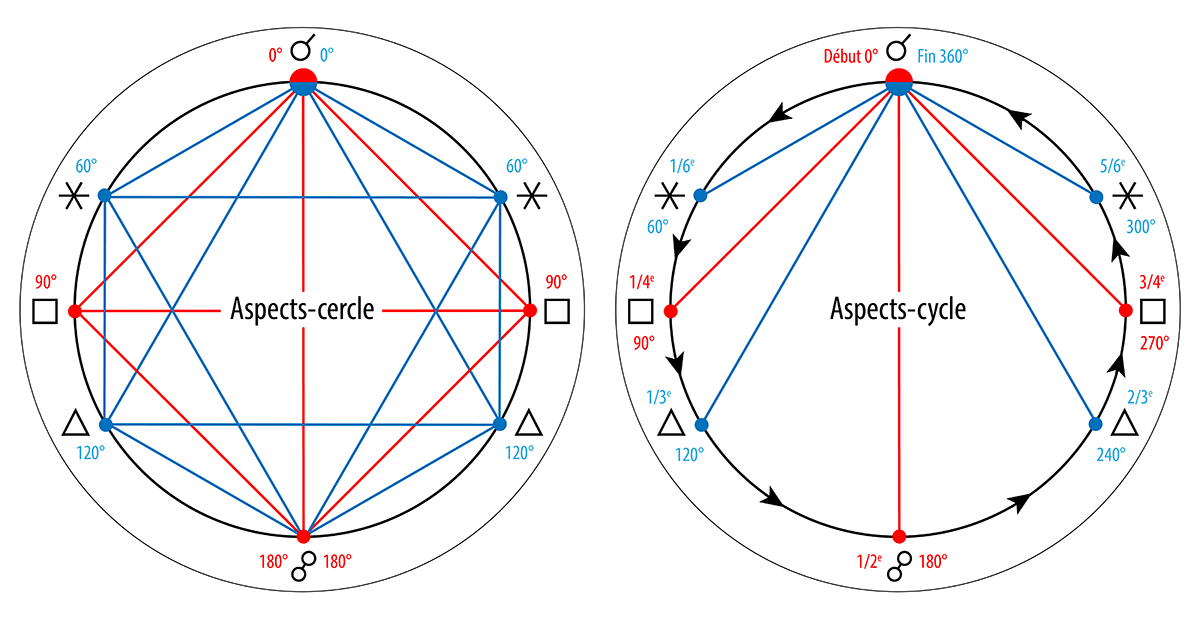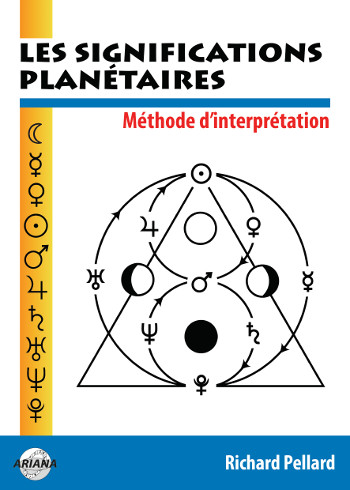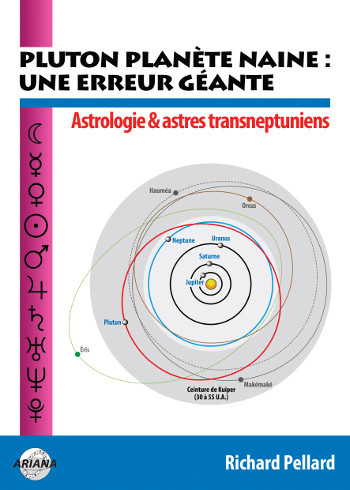Your Planets
Portraits of the Planets
Aspects between Planets
The planetary ages
The planetary families
Planets in Signs
The Planets in comics



For more than 2500 years astrologers have had only one concept intuitive and empirical of what the objective reality of an Aspect is. They confined themselves to observing empirically certain real effects and imagining unreal ones. Very rare and very embryonic have been the attempts at conceptualization and therefore at theorization, such as that exposed by Ptolemy in the 2nd century and that proposed by Kepler in the 17th. Both resulted in erroneous explanations and failures. It is only in the 20th century that the concept of Aspect began to be truly elaborate, making it possible to distinguish the true from the false in the antique and traditional notions and formulate a rational explanatory theory through an overall conception of astrology. The contemporary design and graphical representation of the Aspects are the product of a long history, and the very idea of Aspect has evolved over the millennia.
The planets are the first effector astrological. The Aspect is therefore an essential astrological entity, since it defines both the key frequencies of a cycle (Aspects of a planet to itself during its geocentric period) or an intercycle (privileged relationship that is periodically established between two or more planets).
In contemporary sky charts, the Aspects appear in a central position in the middle of the zodiacal circle, and are presented in the form of angular deviations between the planets, deviations which are measured in ecliptic longitudes. The set of Aspects thus draws a geometric figure simple or complex, made up of line segments whose association produces more or less regular polygons.
For the astrologer, one of the major challenges of the interpretation of a Chart is to decipher the meaning of these planetary interactions. To do this, he must understand the organization of Aspect systems, count them, classify them, prioritize, identify the points of junctions or disjunctions. At the end of these operations, which he performs in order or disorder, intuitively or rationally, he is supposed to be able to describe the reciprocal influences between different “astro-psychological poles” or functional entities of which the planets are the agents, and even to foresee or predict how and when these arrangements are likely to evolve.
All this seems obvious and has existed since the birth of astrology. This is however not the case. The contemporary design and graphical representation of the Aspects are the product of a long history, and the very idea of Aspect has evolved over the millennia. It is therefore appropriate here to clearly differentiate the Aspect as concept and as concept.
The concept is a fuzzy and vague elementary knowledge drawn from impressions, intuitions, empirical observations and/or transmitted ideas which report it. It retains only the most obvious and summary characteristics of an object or phenomenon. It dispenses with explanatory logical theory, for which is substituted that of analogies and correspondences.
The concept originates from the concept, but it is a more elaborate and abstract knowledge. It only makes sense if it is linked to a set of other concepts with which he forms a constructed theory whose purpose is to provide a causal, logical and plausible explanation of the properties of an object or phenomenon. Its nature is to be as clear and precise as possible, and its vocation to sort out the notions to keep only those that can be considered as true, that is to say corresponding to a reality.
The natural progression of knowledge going from concept to concept, for more than 2500 years astrologers had only one concept intuitive and empirical of what the objective reality of an Aspect is. They confined themselves to observing empirically certain real effects and imagining unreal ones. Very rare and very embryonic have been attempts at conceptualization and therefore at theorization, such as that exposed by Claudius Ptolemy at 2nd century and that proposed by Johannes Kepler in the 17th. Both resulted in erroneous explanations and failures. It is only in the 20th century that the concept of Aspect began to be truly elaborate, making it possible to distinguish the true from the false in the antique and traditional notions and formulate a rational explanatory theory through an overall conception of astrology.
It will be noted that this very long persistence of the empirical notions and the late appearance of explanatory theories consisting of linked and articulated concepts is not specific to astrology: all knowledge and sciences have proceeded in the same way. Let us not forget that science in its current definition, rationalist and experimental, emerged only in the 17th century. It then constantly developed by accumulating progress in the knowledge of physical laws. This is not the case with astrology, which remained until the 20th century one stagnant knowledge based on mostly obsolete notions and doctrines, for reasons and unreasonableness that need not be mentioned here.
This text is accompanied by video animation below. It is the essential complement, since it both summarizes and illustrates it abundantly. Number of explanations about notions and concepts which are developed textually are indeed better understood in the form of these animated images. You are therefore advised to see the chapters of the video, which are timed at the beginning, each time reading the text seems to require it. This video has also been divided into several shorter thematic videos that can be found in the different chapters.

There are only two possible definitions of what an Aspect is: the first is of order spatial and the second order temporal. In the first case, it’s a bow formed by two half-lines intersecting two planetary positions located on the circumference of the ecliptic plane. According to this definition, an Aspect is therefore a angle, which can also, in the case of squares, trines and sextiles, to be one of consecutive segments of a regular polygon. It is then measured in degrees of ecliptic longitude.
In the second case, an Aspect is a characteristic phase of a unit of time, the cycle. This phase is then measured in hours, days, years depending on the duration of a cycle (Aspects of a planet to itself) or of a intercycle (Aspects between two planets). And the problem of defining what an Aspect is comes from the fact that this temporal phase can be transposed into a spatial frame of reference, representing it geometrically by the same angle in a cycle graph. In other words, the hours, days, years which are the units of measurement of the duration of a cycle can be transposed into degrees, minutes and seconds of arc on a circle.

How then to distinguish, in this space-time of the Aspects, which comes under the space and what belongs to time? And which of these two essential parameters should be given priority? Astrology being a knowledge based on the cyclic durations of planetary movements and therefore on predictability, the answer is in the question. But it is not useless, to be convinced of this, to wonder what the first astronomers-astrologers could really think of it. After which we can apprehend with full knowledge of the facts the epistemological break that occurred in the design of the Aspects during the second half of the 20th century.
The Mesopotamian pioneers of astronomy and astrology were not the geometricians of an abstract space crossed by angles. Their religion encouraged them to think of the celestial movements as the expression of the will of their gods and if they auscultated the sky, it was certainly by curiosity, but this one was oriented by a utility optics. This perspective required them to be able to plan the events likely to occur during such or such planetary conjunction. They were also priests in the service of their rulers, and to govern is to foresee. Their relationship to the Aspects was therefore not geometric-abstract, but temporal-concrete. They did not regard the Aspects as angles in space, but as the characteristic phases of cycles or intercycles.
A cycle and its most important characteristic phases can certainly be represented by angles measured on the circumference of a circle, and Mesopotamian astrologers-astronomers knew about this geometric figure. But they preferred to present the astronomico-astrological events in general and the Aspects in particular in the form of lists indicating their chronological succession. It is only when the Hellenistic culture will assimilate their knowledge towards the 5th-4th centuries BCE than the circle may begin to be increasingly used as spatial representation of temporal phenomena. Greek culture was indeed very fond of geometry, so much so that those who mastered this science enjoyed the highest consideration.
It is therefore due to the merger between Babylonian astrology and the Hellenistic knowledge that the cycles could have metamorphosed into circles, and their phases into angles. Before this meeting, archaic Greek observational astronomy was very little developed and any astrological concern was absent. By integrating both Mesopotamian astronomy and astrology, Hellenistic culture imposed its geometric hallmark. And it was then, and only then that the Aspects, phases of cycles or intercycles for the Mesopotamians, were transformed into angles of circles and therefore that the time seemed to become a pure space. We must bear in mind this journey that led from the cycle to the circle and then from the circle to the cycle before answering the question “What is a Look?”
An Aspect is not a fixed angle in a circular geometric space, contrary to what most astrologers believe and think since at least Ptolemy. But let us note that even these consider the Aspect under its dynamic angle, therefore cyclic, when they use it in the forward-looking practice of Transits. An Aspect is the characteristic phase of a cycle or intercycle, which can be represented in the form of an angle intercepting two points of the circumference of a circle: there is here, not a nuance, but a fundamental difference between these two conceptions of what an Aspect is.
▶ Aspects theory and practice
▶ Les aspects, phases d’un cycle
▶ Aspects : existe-t-il un modèle traditionnel ?
▶ Aspects : théorie et bilan conditionaliste
▶ Introduction à l’interprétation des aspects
▶ The planetary Aspects and their orbs
▶ Les Aspects kepleriens
▶ Les “aspects” aux Angles
▶ Chronologie des Aspects et Transits
▶ Les Aspects planétaires

Les significations planétaires
par
620 pages. Illustrations en couleur.
La décision de ne traiter dans ce livre que des significations planétaires ne repose pas sur une sous-estimation du rôle des Signes du zodiaque et des Maisons. Le traditionnel trio Planètes-Zodiaque-Maisons est en effet l’expression d’une structure qui classe ces trois plans selon leur ordre de préséance et dans ce triptyque hiérarchisé, les Planètes occupent le premier rang.
La première partie de ce livre rassemble donc, sous une forme abondamment illustrée de schémas pédagogiques et tableaux explicatifs, une édition originale revue, augmentée et actualisée des textes consacrés aux significations planétaires telles qu’elles ont été définies par l’astrologie conditionaliste et une présentation détaillée des méthodes de hiérarchisation planétaire et d’interprétation accompagnées de nombreux exemples concrets illustrés par des Thèmes de célébrités.
La deuxième partie est consacrée, d’une part à une présentation critique des fondements traditionnels des significations planétaires, d’autre part à une présentation des rapports entre signaux et symboles, astrologie et psychologie. Enfin, la troisième partie présente brièvement les racines astrométriques des significations planétaires… et propose une voie de sortie de l’astrologie pour accéder à une plus vaste dimension noologique et spirituelle qui la prolonge et la contient.
Téléchargez-le dès maintenant dans notre boutique

Pluton planète naine : une erreur géante
par
117 pages. Illustrations en couleur.
Pluton ne fait plus partie des planètes majeures de notre système solaire : telle est la décision prise par une infime minorité d’astronomes lors de l’Assemblée Générale de l’Union Astronomique Internationale qui s’est tenue à Prague en août 2006. Elle est reléguée au rang de “planète naine”, au même titre que les nombreux astres découverts au-delà de son orbite.
Ce livre récapitule et analyse en détail le pourquoi et le comment de cette incroyable et irrationnelle décision contestée par de très nombreux astronomes de premier plan. Quelles sont les effets de cette “nanification” de Pluton sur son statut astrologique ? Faut-il remettre en question son influence et ses significations astro-psychologiques qui semblaient avérées depuis sa découverte en 1930 ? Les “plutoniens” ont-ils cessé d’exister depuis cette décision charlatanesque ? Ce livre pose également le problème des astres transplutoniens nouvellement découverts. Quel statut astrologique et quelles influences et significations précises leur accorder ?
Enfin, cet ouvrage propose une vision unitaire du système solaire qui démontre, chiffes et arguments rationnels à l’appui, que Pluton en est toujours un élément essentiel, ce qui est loin d’être le cas pour les autres astres au-delà de son orbite. Après avoir lu ce livre, vous saurez quoi répondre à ceux qui pensent avoir trouvé, avec l’exclusion de Pluton du cortège planétaire traditionnel, un nouvel argument contre l’astrologie !
Téléchargez-le dès maintenant dans notre boutique